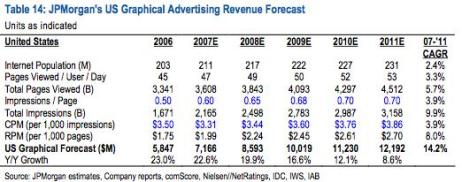 In my last post I looked at some of the assumptions behind estimated virtual good revenue for a virtual world. Next I’m going to look at traditional advertising revenue, ie. simple banner ads. This is excluding the more interesting and exciting possibilities of interactive marketing campaigns and branding.
In my last post I looked at some of the assumptions behind estimated virtual good revenue for a virtual world. Next I’m going to look at traditional advertising revenue, ie. simple banner ads. This is excluding the more interesting and exciting possibilities of interactive marketing campaigns and branding.
The cost of advertising is often measured using CPM, or cost per mille. For banner advertising, this is the cost per thousand impressions. The CPMs for Internet advertising are much lower then other medium, to put it in perspective, in 2006, Internet advertising had a CPM of $3.50 while Network TV had $21.75, Magazines $16.60 and Newspapers $18.69. Below are some Internet CPM forecasts from JPM Morgan.

In-game advertising
According to in-game advertising network IGA CEO Justin Townsend, virtual networks are too small for these kind of ads,
these are mainly creatively-driven environments and frankly not open to advertising. And if they are, it’s hard to get one set of advertising standards defined through all the different virtual world companies. If you wanted to provide ads into virtual worlds, it would be one-off bespoke, as opposed to aggregating ten virtual worlds together and providing a decent amount of reach to consumers.”
This is true for the most part, but as the industry develops and ad sizes are standardised, this will change. To determine what sort of CPMs virtual worlds might get you need to look at its closest comparable. Current in-game CPMs might be one comparable, I’ve heard some reports of CPMs at $20, and Sony’s new game Pain is offering advertising at a CPM of $30. I think the current in-game CPM rates are probably higher than what you’d expect in a virtual world as there is more control over ad placement and where the users attention is directed. Also, currently the investory level for in-gaming is low, once more and more games include advertising, and potentially virtual worlds, I would expect CPMs to fall.
Social network CPMs
Another comparable might be social networks, the similiarity being the access to detailed user infomation and that people are using them to interact with other people, but in the case of virtual worlds, in a much more immersive way. These are lower than the average online CPMs (JPMorgan estimates $3.31 in ’07), Techdirt explains why,
Ads work on Google because people are looking for information. They do a search, and if the advertisement shows information that helps with the query, that makes everyone happy. However, when it comes to a social network, usage is quite different. People aren’t looking for information about products — they’re looking to communicate with friends. In that environment, ads are seen as an intrusion — which is the exact opposite of ads in a search world.
Reports vary quite a bit on actual social network CPMs, here is a round up: Facebook (according to Bear Sterns research, $0.88 blended CPM, but prime CPM up to $10), MySpace ($0.10 – $3.00), Flux ($1.50), Friendster ($0.04).
Virtual world CPMs
Will future virtual world CPMs be somewhere in between? In-game CPMs are high right now, but as it becomes more common, there isn’t going to be enough demand, and CPMs will fall. Unlike online advertising, in-game advertising isn’t going to attract the same array of verticals. If using for forecasts, I would be conservative and assume that virtual world CPMs will be closer to social networks.
Also posted at Citypixel’s blog.



 Posted by James
Posted by James 

